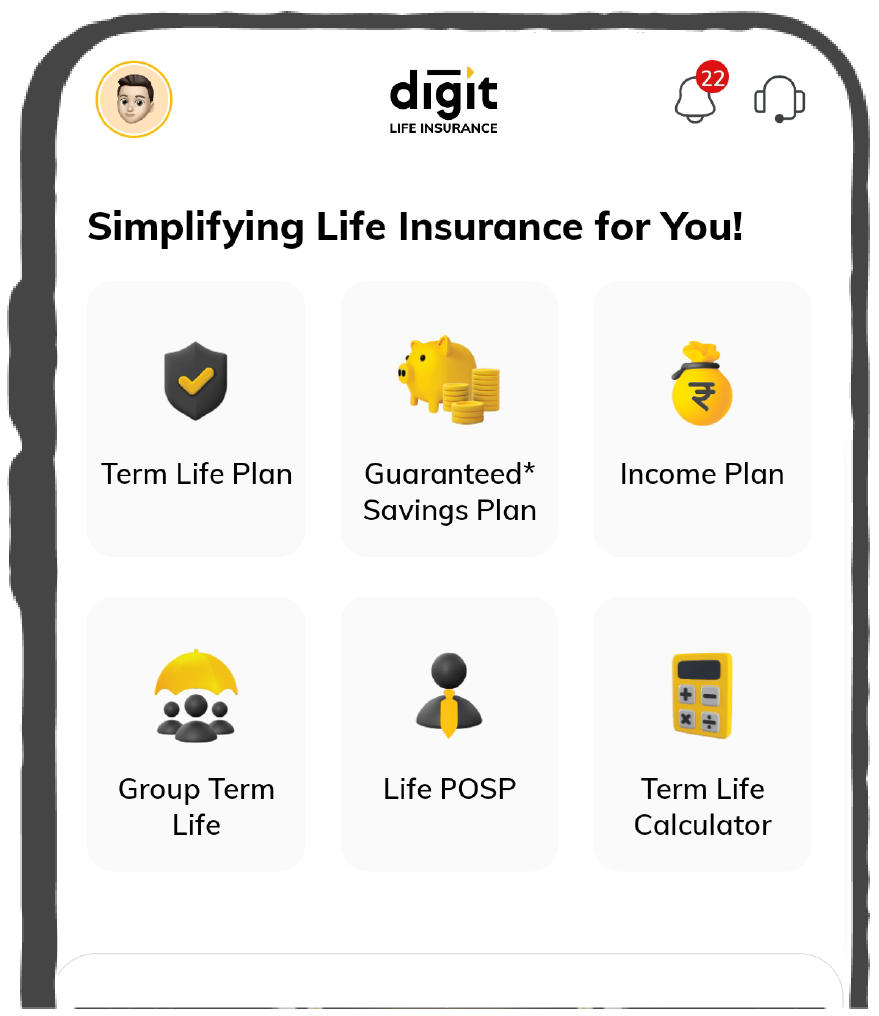How to Compare Term Insurance Plans & Benefits in 2026?
Term insurance is the most popular type of insurance. It is a simple and affordable way to ensure financial security for your loved ones in case of an unfortunate event. However, with various options available, finding the best fit for your needs can seem difficult.
This guide aims to simplify that process, offering a thorough comparison of term insurance plans. It will assist you in navigating through various term insurance plans, spotlighting their unique features and benefits to ensure you make an informed decision that secures your family's future in the most efficient way possible.

Table of Contents

What is Term Insurance and its Features?
Affordability
Term insurance is generally more affordable than other types of life insurance, making it an attractive option for individuals seeking basic life coverage.Flexibility
Term insurance plans offer flexibility in terms of coverage duration, ranging from 5 to 30 years or even more in some cases.Pure Protection
Term insurance policies are designed to provide a lump sum payment (death benefit) to the beneficiaries if the insured individual passes away during the policy's term.Why is it Important to Compare Term Insurance Plans?
1. Finding the Best Value
Different insurers offer varying premium rates for the same coverage. By comparing you can identify the most cost-effective option without compromising on coverage. Ensure that the coverage provided by each plan aligns with your financial goals and risk tolerance. Look for factors like the sum assured, policy term and riders.2. Understand Features and Benefits
Many term insurance plans offer additional riders to enhance coverage. Compare the availability and costs of riders such as a critical illness rider, an accidental death benefit rider, and disability benefits. Comparing these features helps in assessing the overall value of the policy. Also, check if the premiums paid are eligible for tax deductions under applicable tax laws.3. Claim Settlement
The purpose of insurance is to provide financial relief to the family when they have lost the breadwinner. In such times, the most important thing is how efficiently the insurance claim is settled.
Hence, by researching and comparing the claim settlement ratio of different insurers, you can choose a provider known for promptly honouring claims, thus ensuring a smooth process for your beneficiaries during a difficult time.
4. Customization
Depending on your lifestyle, age, and other factors, you might require some features in your plan, while you might not need a few others. By comparing different plans, you can tailor your coverage to suit your needs and budget, ensuring you're not paying for unnecessary features.5. Cost Effectiveness
As much as it is important to have sufficient coverage for yourself, it is also essential to optimise the coverage as per your budget. Thus, comparing term plans allows you to find the most affordable one that offers adequate coverage, helping you maximise the value of your insurance investment.
Different Ways to Compare Term Life Insurance Plans
Learn about different ways and tools to compare term insurance plans, making it easier for you to decide.
- Online Aggregators and Comparison Websites: Multiple online platforms provide tools to compare term insurance plans from different insurers. These websites offer a comprehensive view of various plans, allowing you to compare premiums, coverage details, and features in one place.
- Independent Financial Advisors: Consulting an independent financial advisor or insurance consultant can provide personalised guidance in comparing term insurance plans. An advisor can help you understand the intricate details of different policies and assist in choosing a plan that meets your specific requirements.
- Company Websites and Brochures: Visiting the official websites of insurance companies and reviewing their product brochures can provide detailed insights into their term insurance plans. Most insurers offer online calculators to estimate premiums and coverage amounts, allowing you to compare multiple plans side by side.
- Direct Interaction with Insurers: Engaging directly with insurance company representatives can help in obtaining clarification on policy features, discounts, and specific queries related to the plans. Contacting the customer service teams of different insurers can provide valuable information for your comparison.
Types of Term Insurance Plans in India
When choosing a term insurance plan, consider your financial goals, liabilities, and your family's specific needs. Each type of term insurance has its own advantages and is designed for different purposes:
Factors to Consider Before Comparing Term Insurance Companies
1. Claim Settlement Ratio of the Insurer
When purchasing a term plan, it's crucial to take into account the insurer's claim settlement ratio. This ratio indicates the number of claims settled by a company against the total number of claims received. Thus, a good claim ratio reflects the company's efficiency in settling claims, the basic expectation any policyholder has while purchasing an insurance policy.
Hence, assess your insurer's track record in settling claims promptly and efficiently, ensuring your beneficiaries receive the promised benefits hassle-free.
2. Credibility and Track Record of Insurer
When comparing insurance companies, it is important to consider their credibility and track record. Evaluating the insurer's reputation involves examining its history, financial stability, and customer feedback. A company that has been in the market for a long time, consistently demonstrates strong financial performance, and receives positive reviews is likely to be a dependable choice.
Regulatory bodies also provide significant insights into an insurer's credibility. This research helps ensure that your insurer is well-regarded and capable of fulfilling its obligations, particularly during challenging times.
3. The Amount Settlement Ratio
While Claim Settlement Ratio depends on the number of claims, amount settlement ratio is another critical metric that focusses on the total value of claims settled rather than the number of claims. It represents the proportion of the total amount of claims paid by an insurer compared to the total amount of claims filed by policyholders over a specific period.
A higher Amount Settlement Ratio indicates that an insurer not only settles a number of claims but also pays out a significant portion of the claimed amounts, showcasing financial stability.
4. Operational Efficiency of the Insurer
Operational efficiency measures how well an insurance company conducts its business processes, from policy issuance to claim settlement. Check how well and efficiently the insurer can handle a customer complaint or issues in paperwork.
High operational efficiency indicates a streamlined process, lower operational costs, and quicker response times, benefiting policyholders through faster and hassle-free service.
An insurer that leverages advanced technology and maintains a high level of operational efficiency is likely to offer more reliable and convenient services, making it a desirable choice for consumers.
5. Underwriting Process
Understand the medical underwriting process for each insurer. Some companies may offer simplified underwriting, while others may require comprehensive medical assessments. Inquire about potential premium loadings based on your health condition, lifestyle habits, or occupation. This can significantly impact the cost of your policy. This underwriting is used in Life, Term and Health insurance. Hence, always consider the underwriting process before choosing any policy.6. Scale of Business
There is a difference between working with small and huge numbers. An insurer's scale of business reflects its market presence, product range, and the volume of policies underwritten.
A larger scale often means a more diverse product offering and the ability to spread risk more effectively, leading to more competitive pricing, stability, quality and accessibility of services offered to policyholders.
Analysing an insurer's scale helps understand its capacity to meet your insurance needs comprehensively.
7. Online Tools and Customer Service
Check if the insurer offers online facilities for policy management, premium payments, and accessing policy documents. Assess the quality of customer service and support provided by the insurance company. Prompt and efficient customer service can be crucial during the policy term.Factors to Consider Before Comparing Term Insurance Plan Benefits & Coverages
1. Assess the Coverage You Require
The most crucial step in buying term insurance is determining the right amount of insurance coverage required. It must be evaluated based on several factors like age, savings, income, liabilities, lifestyle, financial goals, etc.
Usually, experts suggest that one must have coverage of at least 10-15 times their annual income, based on their lifestyle. However, to get a more accurate idea of the coverage required, you must check the Human Life Value Calculator.
Now, according to your requirements, evaluate the range of coverage provided by each plan for a given premium, including the sum assured, riders, and any additional benefits.
2. Premium Rates and Your Budget
Premium is the amount that you pay to your insurer in return for the coverage provided. Thus, after deciding your required sum assured, compare the premium amounts for that coverage across different plans, considering factors like age, health condition, and smoking habits.
You can also select a premium term and frequency that suits your finances. You can select a single premium or regular premium and pay it monthly, quarterly, half-yearly, or annually.
Pro Tip: Buy term insurance early on in life. The younger you are, the lesser the premium!
3. Policy Term
Assess the term durations available with different plans. Consider your financial responsibilities and the time period you want to be covered. Some term insurance plans offer the option to renew the policy at the end of the term without the need for medical underwriting. Consider if this feature is important for your long-term planning.4. Rider Options
While you have covered the basic financial requirements of your dependents with a term plan, you must also explore the availability of riders. Riders provide extra coverage and benefits for unusual circumstances, thus helping you tailor your coverage per your requirements.
To enhance your coverage, check out rider options like accidental death benefit, waiver of premium, or disability cover.
5. Exclusions and Limitations
Carefully read through the policy documents to understand the exclusions and limitations of the term insurance plan. Be aware of any specific conditions or situations that the policy may not cover.Premium Payment Options and Flexibility in Term Insurance Plans
When choosing a term insurance plan, one key factor is the premium payment options and flexibility. Below are the common premium payment options:

Why Use a Term Insurance Calculator to Compare Plans?
A term insurance calculator is an online tool designed to help individuals estimate either the coverage amount or the premium for term insurance plans based on their requirements and financial details. Here are a few reasons why:
1. Personalised Estimates
A term insurance calculator allows you to input your specific details, such as age, income, and coverage needs. This helps generate personalised premium estimates, making it easier to find a plan that fits your budget and requirements.
2. Comparison of Multiple Plans
These calculators provide a side-by-side comparison of different insurance plans from various providers. This way, you can easily compare premium rates, coverage options, and benefits, ensuring you choose the best plan for your needs.
3. Time-Saving
Instead of manually researching and comparing different plans, a term insurance calculator does the heavy lifting for you. It quickly provides the necessary information, saving you time and effort.
4. Cost-Effective
Comparing multiple plans can help you identify the most affordable options that still offer adequate coverage, ensuring you get the best value for your money.
5. Informed Decision-Making
With all the information at your fingertips, you can make a more informed decision about which term insurance plan to choose. This reduces the risk of underinsuring or overpaying for coverage.
Common Exclusions in Term Insurance Plans
Insurers often include exclusions in their policies where they may not pay the claim. Awareness of these exclusions can help you make a more informed decision when choosing a term insurance plan. Here are some common exclusions found in term insurance policies:
Understanding these exclusions can help you choose a policy that aligns with your needs and lifestyle. Always read the policy documents carefully and clarify any doubts with the insurer before making a decision.
Choosing the right term insurance plan requires careful consideration of various factors such as premiums, coverage amount, policy term, claim settlement ratio, and the insurer's reputation. Utilising online aggregators, seeking advice from financial professionals, and directly interacting with insurers can streamline the comparison process and help you make an informed decision.
By understanding the key components of term insurance and evaluating multiple plans, you can select a policy that offers comprehensive protection for your loved ones and aligns with your financial goals and priorities.
Frequently Asked Questions
Is it secure to buy online term insurance plans?
Is it better to opt for a higher sum assured or a lower premium when comparing term insurance plans?
Can I switch to a different term insurance plan after purchasing one?
Can we buy two term insurance policies?
Can I extend my term plan duration?
What are the payout options in term insurance?
What is tele medical in term insurance?
How do I know which term insurance is best?
What is the most common term insurance?
How do I compare different term insurance plans?
When comparing term insurance plans, reviewing several key factors is crucial.
- Assess the premium cost and ensure it aligns with the coverage provided.
- Analyse the sum assured and policy tenure to match your needs.
- Examine the insurer's claim settlement ratio to gauge reliability.
- Understand the value of any riders and exclusions to get full coverage.
- Lastly, feedback from other policyholders regarding customer service and claim processes should be considered.
What is the ideal policy term for term insurance?
Is it better to buy term insurance online or offline?
Can I change my term insurance plan after purchase?
What are the tax benefits associated with term insurance?
Does age affect the premium for term insurance?
How does a 1 crore term plan compare to lower coverage options?
Should I choose a plan with riders like critical illness or accidental death?
Other Important Articles Related to Term Insurance










